Donghao Zhou
SceneDecorator: Towards Scene-Oriented Story Generation with Scene Planning and Scene Consistency
Oct 27, 2025Abstract:Recent text-to-image models have revolutionized image generation, but they still struggle with maintaining concept consistency across generated images. While existing works focus on character consistency, they often overlook the crucial role of scenes in storytelling, which restricts their creativity in practice. This paper introduces scene-oriented story generation, addressing two key challenges: (i) scene planning, where current methods fail to ensure scene-level narrative coherence by relying solely on text descriptions, and (ii) scene consistency, which remains largely unexplored in terms of maintaining scene consistency across multiple stories. We propose SceneDecorator, a training-free framework that employs VLM-Guided Scene Planning to ensure narrative coherence across different scenes in a ``global-to-local'' manner, and Long-Term Scene-Sharing Attention to maintain long-term scene consistency and subject diversity across generated stories. Extensive experiments demonstrate the superior performance of SceneDecorator, highlighting its potential to unleash creativity in the fields of arts, films, and games.
DisCo-Layout: Disentangling and Coordinating Semantic and Physical Refinement in a Multi-Agent Framework for 3D Indoor Layout Synthesis
Oct 02, 2025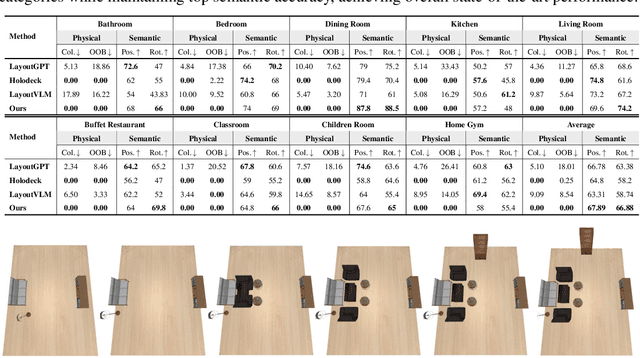
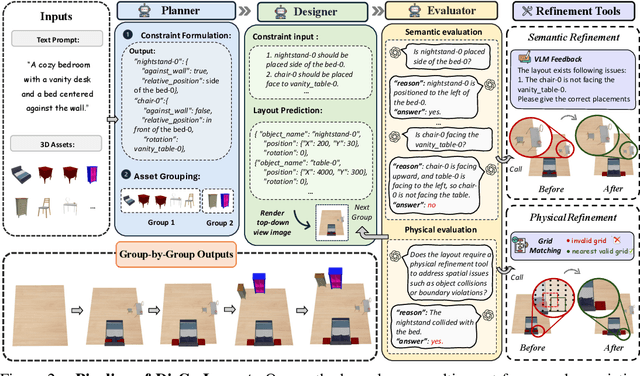
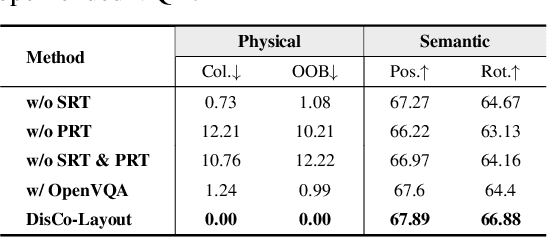
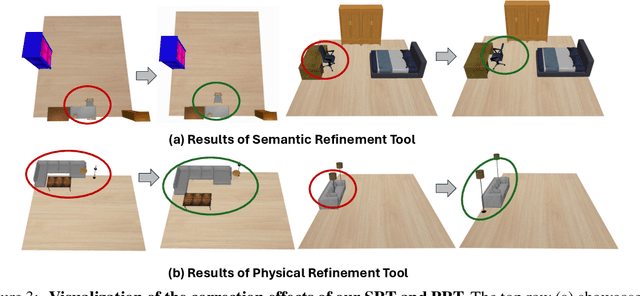
Abstract:3D indoor layout synthesis is crucial for creating virtual environments. Traditional methods struggle with generalization due to fixed datasets. While recent LLM and VLM-based approaches offer improved semantic richness, they often lack robust and flexible refinement, resulting in suboptimal layouts. We develop DisCo-Layout, a novel framework that disentangles and coordinates physical and semantic refinement. For independent refinement, our Semantic Refinement Tool (SRT) corrects abstract object relationships, while the Physical Refinement Tool (PRT) resolves concrete spatial issues via a grid-matching algorithm. For collaborative refinement, a multi-agent framework intelligently orchestrates these tools, featuring a planner for placement rules, a designer for initial layouts, and an evaluator for assessment. Experiments demonstrate DisCo-Layout's state-of-the-art performance, generating realistic, coherent, and generalizable 3D indoor layouts. Our code will be publicly available.
HERO: Hierarchical Extrapolation and Refresh for Efficient World Models
Aug 25, 2025
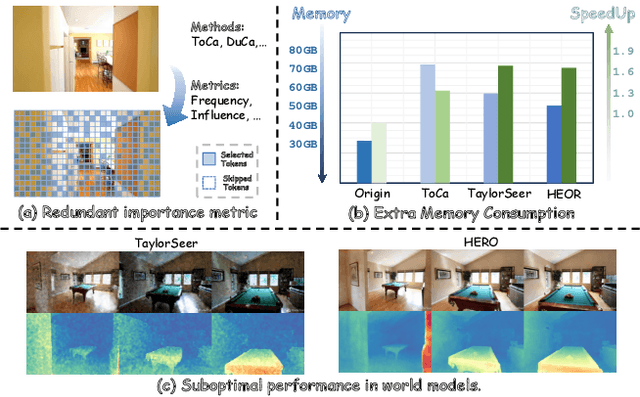


Abstract:Generation-driven world models create immersive virtual environments but suffer slow inference due to the iterative nature of diffusion models. While recent advances have improved diffusion model efficiency, directly applying these techniques to world models introduces limitations such as quality degradation. In this paper, we present HERO, a training-free hierarchical acceleration framework tailored for efficient world models. Owing to the multi-modal nature of world models, we identify a feature coupling phenomenon, wherein shallow layers exhibit high temporal variability, while deeper layers yield more stable feature representations. Motivated by this, HERO adopts hierarchical strategies to accelerate inference: (i) In shallow layers, a patch-wise refresh mechanism efficiently selects tokens for recomputation. With patch-wise sampling and frequency-aware tracking, it avoids extra metric computation and remain compatible with FlashAttention. (ii) In deeper layers, a linear extrapolation scheme directly estimates intermediate features. This completely bypasses the computations in attention modules and feed-forward networks. Our experiments show that HERO achieves a 1.73$\times$ speedup with minimal quality degradation, significantly outperforming existing diffusion acceleration methods.
Trade-offs in Image Generation: How Do Different Dimensions Interact?
Jul 29, 2025Abstract:Model performance in text-to-image (T2I) and image-to-image (I2I) generation often depends on multiple aspects, including quality, alignment, diversity, and robustness. However, models' complex trade-offs among these dimensions have rarely been explored due to (1) the lack of datasets that allow fine-grained quantification of these trade-offs, and (2) the use of a single metric for multiple dimensions. To bridge this gap, we introduce TRIG-Bench (Trade-offs in Image Generation), which spans 10 dimensions (Realism, Originality, Aesthetics, Content, Relation, Style, Knowledge, Ambiguity, Toxicity, and Bias), contains 40,200 samples, and covers 132 pairwise dimensional subsets. Furthermore, we develop TRIGScore, a VLM-as-judge metric that automatically adapts to various dimensions. Based on TRIG-Bench and TRIGScore, we evaluate 14 models across T2I and I2I tasks. In addition, we propose the Relation Recognition System to generate the Dimension Trade-off Map (DTM) that visualizes the trade-offs among model-specific capabilities. Our experiments demonstrate that DTM consistently provides a comprehensive understanding of the trade-offs between dimensions for each type of generative model. Notably, we show that the model's dimension-specific weaknesses can be mitigated through fine-tuning on DTM to enhance overall performance. Code is available at: https://github.com/fesvhtr/TRIG
CellVerse: Do Large Language Models Really Understand Cell Biology?
May 09, 2025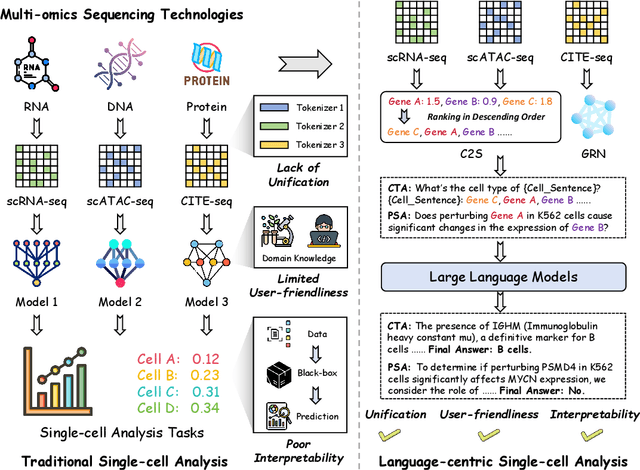
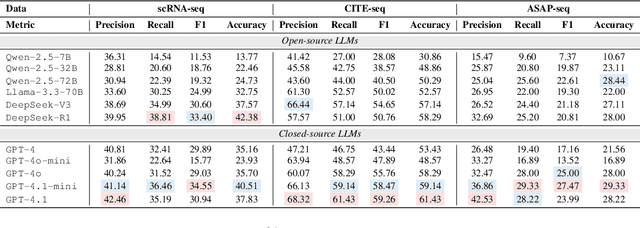
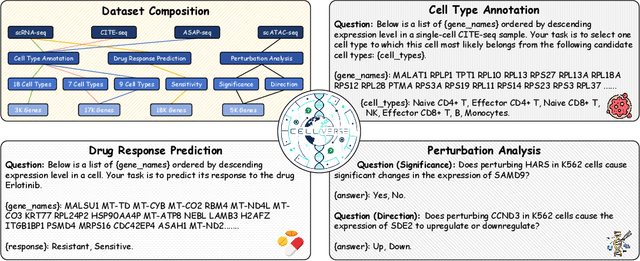
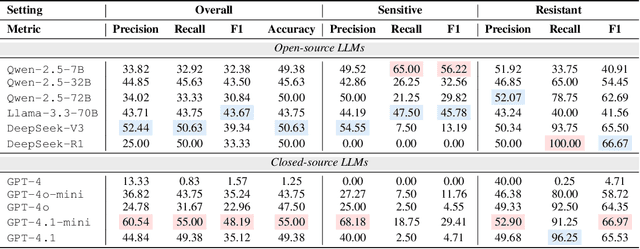
Abstract:Recent studies have demonstrated the feasibility of modeling single-cell data as natural languages and the potential of leveraging powerful large language models (LLMs) for understanding cell biology. However, a comprehensive evaluation of LLMs' performance on language-driven single-cell analysis tasks still remains unexplored. Motivated by this challenge, we introduce CellVerse, a unified language-centric question-answering benchmark that integrates four types of single-cell multi-omics data and encompasses three hierarchical levels of single-cell analysis tasks: cell type annotation (cell-level), drug response prediction (drug-level), and perturbation analysis (gene-level). Going beyond this, we systematically evaluate the performance across 14 open-source and closed-source LLMs ranging from 160M to 671B on CellVerse. Remarkably, the experimental results reveal: (1) Existing specialist models (C2S-Pythia) fail to make reasonable decisions across all sub-tasks within CellVerse, while generalist models such as Qwen, Llama, GPT, and DeepSeek family models exhibit preliminary understanding capabilities within the realm of cell biology. (2) The performance of current LLMs falls short of expectations and has substantial room for improvement. Notably, in the widely studied drug response prediction task, none of the evaluated LLMs demonstrate significant performance improvement over random guessing. CellVerse offers the first large-scale empirical demonstration that significant challenges still remain in applying LLMs to cell biology. By introducing CellVerse, we lay the foundation for advancing cell biology through natural languages and hope this paradigm could facilitate next-generation single-cell analysis.
An Empirical Study of GPT-4o Image Generation Capabilities
Apr 08, 2025Abstract:The landscape of image generation has rapidly evolved, from early GAN-based approaches to diffusion models and, most recently, to unified generative architectures that seek to bridge understanding and generation tasks. Recent advances, especially the GPT-4o, have demonstrated the feasibility of high-fidelity multimodal generation, their architectural design remains mysterious and unpublished. This prompts the question of whether image and text generation have already been successfully integrated into a unified framework for those methods. In this work, we conduct an empirical study of GPT-4o's image generation capabilities, benchmarking it against leading open-source and commercial models. Our evaluation covers four main categories, including text-to-image, image-to-image, image-to-3D, and image-to-X generation, with more than 20 tasks. Our analysis highlights the strengths and limitations of GPT-4o under various settings, and situates it within the broader evolution of generative modeling. Through this investigation, we identify promising directions for future unified generative models, emphasizing the role of architectural design and data scaling.
Dual-Schedule Inversion: Training- and Tuning-Free Inversion for Real Image Editing
Dec 15, 2024



Abstract:Text-conditional image editing is a practical AIGC task that has recently emerged with great commercial and academic value. For real image editing, most diffusion model-based methods use DDIM Inversion as the first stage before editing. However, DDIM Inversion often results in reconstruction failure, leading to unsatisfactory performance for downstream editing. To address this problem, we first analyze why the reconstruction via DDIM Inversion fails. We then propose a new inversion and sampling method named Dual-Schedule Inversion. We also design a classifier to adaptively combine Dual-Schedule Inversion with different editing methods for user-friendly image editing. Our work can achieve superior reconstruction and editing performance with the following advantages: 1) It can reconstruct real images perfectly without fine-tuning, and its reversibility is guaranteed mathematically. 2) The edited object/scene conforms to the semantics of the text prompt. 3) The unedited parts of the object/scene retain the original identity.
Point Cloud Understanding via Attention-Driven Contrastive Learning
Nov 22, 2024



Abstract:Recently Transformer-based models have advanced point cloud understanding by leveraging self-attention mechanisms, however, these methods often overlook latent information in less prominent regions, leading to increased sensitivity to perturbations and limited global comprehension. To solve this issue, we introduce PointACL, an attention-driven contrastive learning framework designed to address these limitations. Our method employs an attention-driven dynamic masking strategy that guides the model to focus on under-attended regions, enhancing the understanding of global structures within the point cloud. Then we combine the original pre-training loss with a contrastive learning loss, improving feature discrimination and generalization. Extensive experiments validate the effectiveness of PointACL, as it achieves state-of-the-art performance across a variety of 3D understanding tasks, including object classification, part segmentation, and few-shot learning. Specifically, when integrated with different Transformer backbones like Point-MAE and PointGPT, PointACL demonstrates improved performance on datasets such as ScanObjectNN, ModelNet40, and ShapeNetPart. This highlights its superior capability in capturing both global and local features, as well as its enhanced robustness against perturbations and incomplete data.
MagicTailor: Component-Controllable Personalization in Text-to-Image Diffusion Models
Oct 17, 2024Abstract:Recent advancements in text-to-image (T2I) diffusion models have enabled the creation of high-quality images from text prompts, but they still struggle to generate images with precise control over specific visual concepts. Existing approaches can replicate a given concept by learning from reference images, yet they lack the flexibility for fine-grained customization of the individual component within the concept. In this paper, we introduce component-controllable personalization, a novel task that pushes the boundaries of T2I models by allowing users to reconfigure specific components when personalizing visual concepts. This task is particularly challenging due to two primary obstacles: semantic pollution, where unwanted visual elements corrupt the personalized concept, and semantic imbalance, which causes disproportionate learning of the concept and component. To overcome these challenges, we design MagicTailor, an innovative framework that leverages Dynamic Masked Degradation (DM-Deg) to dynamically perturb undesired visual semantics and Dual-Stream Balancing (DS-Bal) to establish a balanced learning paradigm for desired visual semantics. Extensive comparisons, ablations, and analyses demonstrate that MagicTailor not only excels in this challenging task but also holds significant promise for practical applications, paving the way for more nuanced and creative image generation.
TripletMix: Triplet Data Augmentation for 3D Understanding
May 28, 2024Abstract:Data augmentation has proven to be a vital tool for enhancing the generalization capabilities of deep learning models, especially in the context of 3D vision where traditional datasets are often limited. Despite previous advancements, existing methods primarily cater to unimodal data scenarios, leaving a gap in the augmentation of multimodal triplet data, which integrates text, images, and point clouds. Simultaneously augmenting all three modalities enhances diversity and improves alignment across modalities, resulting in more comprehensive and robust 3D representations. To address this gap, we propose TripletMix, a novel approach to address the previously unexplored issue of multimodal data augmentation in 3D understanding. TripletMix innovatively applies the principles of mixed-based augmentation to multimodal triplet data, allowing for the preservation and optimization of cross-modal connections. Our proposed TripletMix combines feature-level and input-level augmentations to achieve dual enhancement between raw data and latent features, significantly improving the model's cross-modal understanding and generalization capabilities by ensuring feature consistency and providing diverse and realistic training samples. We demonstrate that TripletMix not only improves the baseline performance of models in various learning scenarios including zero-shot and linear probing classification but also significantly enhances model generalizability. Notably, we improved the zero-shot classification accuracy on ScanObjectNN from 51.3 percent to 61.9 percent, and on Objaverse-LVIS from 46.8 percent to 51.4 percent. Our findings highlight the potential of multimodal data augmentation to significantly advance 3D object recognition and understanding.
 Add to Chrome
Add to Chrome Add to Firefox
Add to Firefox Add to Edge
Add to Edge